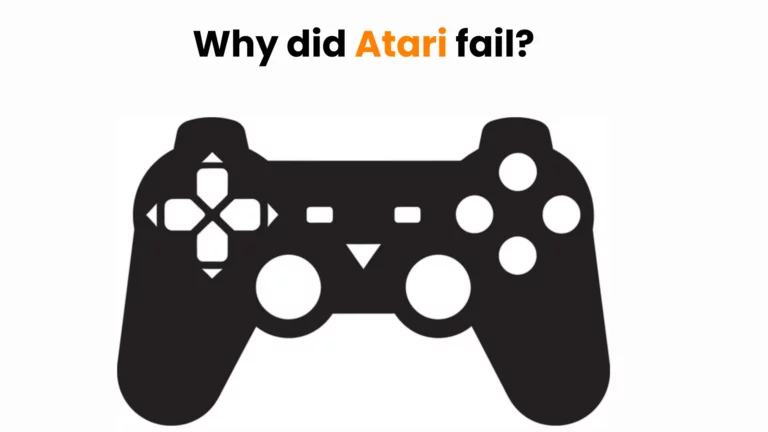Atari, Inc. was an American video game developer and home computer corporation founded in 1972 by Nolan Bushnell and Ted Dabney. It was a Nintendo third-party firm that dominated the video game market from 1975 through the early 1980s. The company designed several systems, including the 400, 2600, 5200, 7800, Lynx, Jaguar, and VCS.
So, when they had such a good product portfolio and a strong foothold, why did Atari fail?
Technology Innovation and Ideas in the Market
Atari was the first company to mass-produce arcade games, paving the way for home gaming systems. The company hired Al Alcorn, an engineer, to create a fundamental Ping-Pong-style video game, which proved more enjoyable to play than he had anticipated. The game was called Pong and was commercially tested at Andy Capp’s Tavern in Sunnyvale, California. Pong was an immediate success for Atari from the moment of its release in 1972. Pong arcade machines sold over 8,000 units, a significant number compared to one of the most popular arcade games at the time, such as the Pinball machine, which did not sell as many. A few years later, in 1977, it launched the Atari 2600 home video gaming machine. Bushnell signed an exclusive agreement with Sears and sold around 150,000 games in the first season alone.
Atari dominated the market for several years until things began falling. Disagreements between Warner’s top executives and Nolan Bushnell ended in Nolan’s resignation in November 1978. Following that, Warner struggled to manage Atari’s employees, losing nearly all of the company’s most excellent programmers. As a result, some of Atari’s top performers left the firm. They didn’t just depart; they founded their own firm, Activision. Activision began producing the best and most popular games, and the corporation was producing various popular games. By 1982, Activision had surpassed Atari as the fastest-growing video game company in the United States, selling $150 million in games annually.
Atari debuted the home version of Pac-Man in 1982, which was eagerly anticipated by gamers all around the world. Pac-Man, on the other hand, fell short of expectations. Instead, it was a terrible disaster that was not worth the wait. As a result, only 7 million of the 12 million cartridges produced by Atari were sold, and many of these were returned by unhappy customers.
Furthermore, following the success of the Atari 2600, the company decided to enter the market with another system. The Atari 5200, the manufacturer’s follow-up to the system, was a massive failure. Although it was more powerful than its predecessor and competitors such as ColecoVision, the 1982 machine was highly criticized for its poorly-designed analog controllers, which refused to center, and high $270 launch price.
In addition, the corporation was competing on two fronts. While Atari’s partner business, Warner, enjoyed the success of the 2600 for as long as it could, Commodore was actively pushing home computers and flatly asking in its advertisements, “Why just buy a video game?” While the VIC-20 was a reasonably limited computer, it could accomplish more than the 2600, and Commodore aggressively reduced its price, debuting it for $299 in late 1980 and selling it for under $100 by 1983. The Commodore 64, which debuted for $599 in 1982 but retailed for $249 by 1983, was more critical.
Atari also sold home computers but had to accept lower margins to compete with Commodore’s prices. Atari’s home computers were excellent, but they were unable to compete with Commodore’s aggressive pricing and marketing. Going high-priced wasn’t an option for the company since Apple had already covered the top end of the market. Then there was Radio Shack, which had locations nationwide and could beat Atari on convenience even if they charged a somewhat higher price.
Meanwhile, Coleco introduced the Colecovision, a technologically advanced console at an affordable price. It could play arcade-quality games, which diminished the 2600’s attractiveness. The 2600 was suddenly vulnerable.
Finally, Atari’s demise was sealed by the infamous Video Game Crash of 1983, a large-scale collapse in the video game industry that lasted until 1985. It primarily affected the US market and is known in Japan as Atari Shock. This was attributed to several factors, including market saturation in terms of game consoles and available games, as well as a trend away from console games in favor of personal computers. The recession was harsh on everyone in the video game industry, including Atari.
Results
Atari changed hands several times after the commercial failures of the Lynx and Jaguar. After a merger with disc drive manufacturer JTS in 1996, the Atari band was sold to Hasbro for $5 million in 1998.
Atari, SA, was in debt after losing tens of millions of dollars since 2005. As a result, Atari Inc. and three of its subsidiaries filed for Chapter 11 bankruptcy in New York.
The company is currently attempting to make a comeback. It even released the Atari VCS, a micro-console designed to pay homage to the Atari 2600, on June 15, 2021.
Their fate is yet to be determined. This post was just one of the case studies showing why companies fail and why did Atari fail.
For more such stories, visit: https://inspireip.com/blog/



